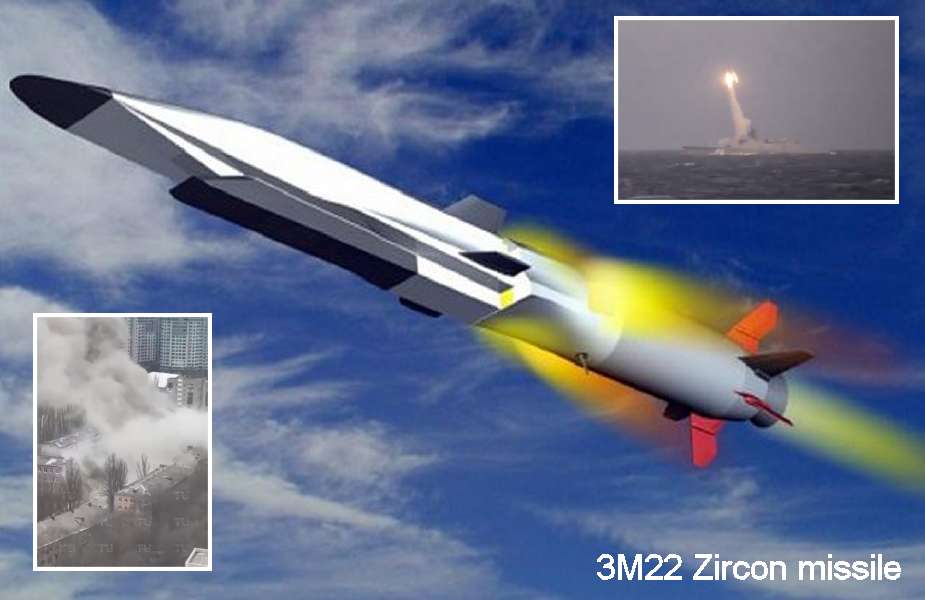Russia deploys Zircon hypersonic missiles to defeat Ukrainian US Patriot air defense systems
On March 25, 2024, the Ukrainian government disclosed an attack by Russia on Kyiv, involving the use of the hypersonic missiles Zircon (also known as 3M22 Tsirkon and recognized within NATO as SS-N-33) which were reportedly launched from Crimea. This offensive, targeting civilian infrastructure, marks the fifth deployment of this weapon since the start of the year, indicating Russia's intent to test Ukraine's defensive capabilities, including against advanced systems like the NATO-supplied Patriot system. The Zircon missile is renowned for being "impossible to intercept" with current defense means, thanks to its exceptional hypersonic speed, flight trajectory, and maneuverability.
Follow Army Recognition on Google News at this link

Russian 3M22 Zircon hypersonic missile (Picture source: Russian social media)
The continued adoption and development of the hypersonic Zircon missile by Russia highlight its persistent quest to dominate the field of advanced military technologies. By focusing on hypersonic weapons like the Zircon, Russia not only advances its capability to innovate militarily but also emphasizes its commitment to an arms race where hypervelocity becomes a supremacy criterion. This advancement places Russia at the forefront of military technologies, surpassing NATO's current capabilities in terms of missile speed and maneuverability. The lack of comparable hypersonic capabilities within NATO underscores a growing technological gap that the Alliance will need to bridge. Thus, the development of the Zircon represents not just progress in the Russian arsenal; it also poses a significant strategic challenge for NATO and its allies, prompting them to accelerate their research and development in hypersonic technology to maintain strategic balance in the coming years.
The initial use of the hypersonic Zircon missile by Russia against civilian targets in Kyiv appears to be a show of force tactic, aimed less at causing immediate damage than at sending a clear message to Russia's adversaries. This approach highlights Moscow's desire to showcase its technological advancement in armament, particularly by demonstrating the capability of its missiles to surpass the most sophisticated defense systems, such as the American Patriot anti-aircraft system. The current use of this weapon, which remains limited in quantity and not yet produced on a large scale, suggests that it serves more as a strategic deterrent gesture than as a conventional warfare tool. Indeed, their production cost is estimated to be between 3 and 4 million dollars per unit.
Furthermore, the launch of these missiles from frigates positioned in the Black Sea demonstrates an effort to enhance the power profile of the Russian navy, which has experienced setbacks since the beginning of the conflict in Ukraine. It appears that Russia is also currently working on the possibility of deploying the Zircon from land-based platforms. On November 3, 2022, TASS announced the design and manufacture of a prototype mobile ground vehicle launcher for the Zirkon as part of a coastal defense missile system.
The use of the Zircon hypersonic missile is part of a broader strategy by Moscow to intensify military pressure on Kyiv, notably through the future use of other long-range armament systems like the Kinjal missile. Investing in advanced and costly military technologies, such as the hypersonic Zircon missile, reveals a deliberate strategy to challenge the defensive capabilities of Ukraine and its allies, testing their readiness to counter new-generation military threats.
The Zircon missile represents a huge advancement in hypersonic cruise missile technology developed by Russia. Powered by a scramjet engine and capable of carrying a nuclear payload, the Zircon was primarily developed for use by the Russian Navy. It can be launched from frigates and submarines using ZS-14 platforms. Achieving impressive speeds of up to Mach 9, the missile stands out for its ability to evade traditional air defense systems due to its blistering speed and advanced stealth capabilities, including plasma stealth.
With a maximum range of 1,000 kilometers and the capability to navigate at cruising speeds reaching Mach 9 thanks to its initial solid-fuel engine followed by its liquid-fueled scramjet, the Zircon poses a big challenge to current air defense systems. Its capability to reach hypersonic speeds, between 5 and 9 times the speed of sound, renders it practically undetectable and thus "uninterceptable" by existing defense means. This feature makes it a strategic tool for offensive missions, allowing for the precise targeting of both terrestrial and maritime objectives.
Operationally, the missile can travel between 135 and 270 nautical miles (250 to 500 kilometers) at low altitudes, and up to 400 nautical miles (740 kilometers) when following a semi-ballistic trajectory, with an average range estimated at 400-450 kilometers. According to some Russian reports, its maximum range could reach 540 nautical miles (1,000 kilometers), while other sources suggest it could strike targets between 1,000 and 2,000 kilometers away, depending on the target type. Equipped with a warhead weighing between 300 and 400 kilograms, the Zircon can be armed with either conventional high explosive (HE) or nuclear payloads of up to 200 kilotons, thus offering considerable operational flexibility for various combat scenarios.
It's important to note that hypervelocity - the ability to achieve and sustain speeds greater than Mach 5 - presents a significant technological challenge, not only in terms of designing and manufacturing missiles capable of reaching such speeds but also in developing defense systems capable of intercepting them.




























